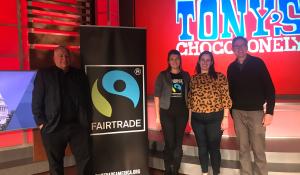

In an ongoing recession that has been difficult for many parts of the country, Cleveland, OH, has had the dubious distinction of being the second most impoverished city in the nation, after Detroit. Census numbers from 2010 indicate that one of every three Cleveland residents lives below the poverty line, and the unemployment rate was hovering over nine percent this summer.
But Cleveland is determined to turn itself around, and it’s now gaining attention for its innovative and successful approach to community economic development. Cleveland is home to the Evergreen Cooperative Corporation (ECC), a network of worker-owned cooperatives built to meet the supply and service needs of local businesses, government offices, and organizations while building wealth and assets within the community.
The city was ready to take part in the Evergreen experiment, having been burned in the past by the conventional ways of bringing business to the city.
“We used to offer all kinds of tax abatements and other incentives to get businesses to move here, but then after a few years, another city would offer other encouragements and many would move away,” says Tracey Nichols of Cleveland’s Department of Economic Development. “Instead of pursuing that model, we want to work on building a healthy economic environment that will endure.”
Bringing Jobs and Money Back
Evergreen was formed in 2008 after the Cleveland Foundation brought together over 40 stakeholders to establish a vision for the revitalization of Cleveland’s Greater University Circle (GUC) region, which includes the city’s university and hospital districts, as well as six residential neighborhoods. The GUC included working-class and impoverished areas with little employment opportunity, despite the fact that they surround some of Cleveland’s largest institutions.
The group realized that local “anchor institutions”—like hospitals and universities— spend $3 billion on goods and services each year. What if they could keep that $3 billion in Cleveland, they asked, and leverage it to benefit the community?
The institutions, it turned out, were eager to source more of their needs locally.
“Evergreen worked closely with its anchor partners to identify supply chain [needs] they might have that an Evergreen company could address,” says Ted Howard, executive director of the Democracy Collaborative, one of the organizing forces of Evergreen. “In a real sense, you could say that we are co-designing businesses with these institutions, who then become Evergreen’s customers.”
But just creating jobs for Cleveland wasn’t enough, says Atlee McFellin, also of the Democracy Collaborative. “Instead, we wanted a model that gave people an ownership stake in what they were doing. We looked at models that had been proven to work in creating jobs and building wealth, and decided that Cleveland was ripe for worker-owned business.”
Green Jobs and More
With grant funding and technical support from the Cleveland Foundation and others, the group created the Evergreen Cooperative Corporation to establish a network of cooperatives to meet the needs of GUC’s anchor institutions and bring jobs and money back to the city. Evergreen launched its two first cooperatives in the fall of 2009: Evergreen Laundry and Evergreen Energy Solutions, also known as the Ohio Cooperative Solar.

Evergreen Energy Solutions.
Evergreen Cooperative Laundry, an industrial-scale green laundry operating out
of a LEED-certified building, does millions of pounds of laundry each week for Cleveland hospitals and hotels. Evergreen Energy Solutions, a solar installation and energy efficiency company, helps local governments utilize federal grant money for renewable energy and efficiency projects, and it also works in the residential arena. So far, Evergreen Energy Solutions has installed over three megawatts of solar energy, and the co-op’s presence in Ohio is expected to double the amount of solar installed in the state in coming years.
A third Evergreen co-op, Green City Growers Cooperative, constructed a hydroponic greenhouse and is expecting its first harvest this winter. Responding to calls from local universities and hospitals for more local food, Green City Growers will grow and package about 3 million heads of leafy greens every year, as well as some 300,000 pounds of fresh herbs.
In the Evergreen model, employees become worker-owners after six successful monthsof employment. At that point, the employee is eligible for no-cost health care benefits and a raise, part of which goes towards buying the employee’s ownership stake in the company. Evergreen worker-owners earn a living wage of almost twice the Ohio minimum wage. And each year, the company’s surplus profits are allocated to capital accounts owned by each worker.
“Rather than a trickle-down, Walmartstyle strategy, Evergreen focuses on economic inclusion and building a local economy from the ground up,” says Howard. “Rather than offering public subsidies to induce corporations to bring what are often low-wage jobs into the city, the Evergreen strategy is catalyzing new businesses that are owned by their employees. Rather than concentrate on workforce training for employment opportunities that are largely unavailable to low-skill and low-income workers, the Evergreen Initiative first creates the jobs, and then recruits and trains local residents to take them.”
Making an Impact
So far, the three Evergreen co-ops have over 50 worker-owners, and planners expect to form a total of six to ten cooperatives with hundreds of workerowners. While owning a stake in the business means more profits are returning to the employees, Evergreen co-ops are also managed democratically, giving each worker-owner a voice in decision making.
“I love telling people what I do for Evergreen, and what it does for me,” says Medrick Addison, a worker-owner at Evergreen Laundry. “You grow, you nurture, you are instrumental in what the co-op becomes—that’s the difference in working at Evergreen versus somewhere else.”
While Cleveland has grabbed headlines in the past for its dismal economy, leaders from cities across the country are now traveling there to see the Evergreen model in action. Two cooperatives in Atlanta are forming under the Atlanta Wealth Building Initiative, and feasibility studies are under way in Washington, DC; Pittsburgh; and Amarillo; with more cities expressing interest in worker co-ops.
“People see Evergreen, and they want it in their own city,” says McFellin. “We are working to create networks of cooperatives like these around the country, taking steps towards a new economy.”
For a toolkit on how to replicate the Evergreen
model, visit evergreencooperatives.com.







